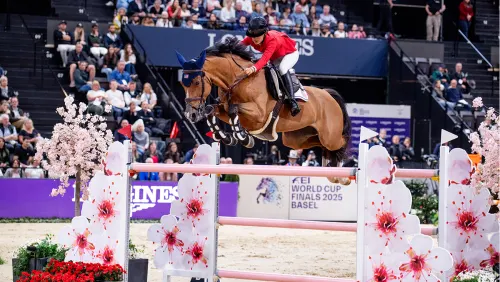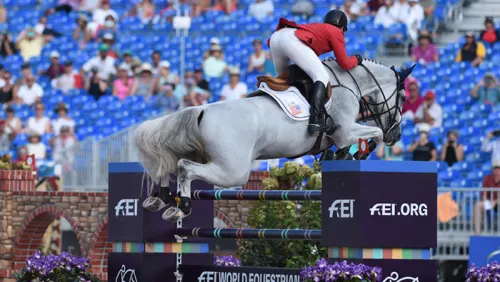Mill Spring, N.C.—Sept. 21
Rob Ehrens became chef d’equipe to the Dutch senior show jumping team in 2004, and the first piece of advice he gave was to himself.
He took a sheet of paper, wrote down the names of chefs d’equipe who had trained him in years past, and compiled a list of strengths and weaknesses under each. While there was no shortage of positive attributes, the greatest of the negative commonalities was miscommunication.
“Communication is what you need to have with all your riders; everyone needs to know what’s going on,” said Ehrens, 60. “I still believe that’s a very important thing: being straightforward and not choosing people because you like the person or they put you under pressure. That doesn’t work in our country—under me.”

Rob Ehrens during the team and individual training session at the 2018 FEI World Equestrian Games. Photo by Erin Gilmore for Shannon Brinkman Photo.
Ehrens has stood at the helm of the team for the past 14 years, when the Dutch won team gold at the 2006 World Equestrian Games in Aachen, Germany, just as they did at the 2014 World Games in Normandy, France, and when they secured team silver at the 2012 Olympic Games in London and finished first at the 2015 European Championships for Seniors in Aachen.
He was also present when they finished 15th at the 2010 Alltech FEI World Equestrian Games (Kentucky), tied for seventh at the Rio 2016 Summer Olympics, and finished dead last at the Furusiyya FEI Nations Cup Jumping Final 2016 in Barcelona (Spain).
“After every Nations Cup and every championship, we evaluate the season,” said Ehrens. “In the years you win [it’s easier to do] because you can celebrate, but I also know many moments that we didn’t win, that we missed the target completely, and then you have to see what went wrong, what can be made better. That is, in fact, what we do the entire year.”
After the Netherlands’ gold-medal sweep at the 2017 Longines FEI Jumping Nations Cup Final—with three of the four combinations returning for the WEG—Ehrens heads to his fourth World Games as chef with the team he believes is his strongest:
Current World No. 1 Harrie Smolders and Don VHP Z N.O.P; Jur Vrieling and VDL Glasgow van het Merelsnest NOP; Frank Schuttert and Chianti’s Champion; Marc Houtzager and Sterrerhof’s Calimero; and Leopold van Asten and VDL Groep Beauty as reserve.
“You cannot select only by name; the rider and horse need to be, at that moment, a combination fit to compete,” said Ehrens. “When you can combine all those elements, and everything goes, from the start of the championship, the way it has to go, then you have a small chance [of winning] a medal.”
The Journey To Chef d’Equipe
Ehrens was born into a family of non-horse enthusiasts in Weert, a town in the southeastern region of The Netherlands. His love for animals led him to Pony Club, and he began jumping at 11.
“We had to go from pony club to dressage before we could jump, but dressage was always the most difficult part,” said Ehrens. “It took very long, so we always looked anxiously [towards] the jumping lesson.”
Riding quickly became top priority when his father bought him a pair of horses at 16, though his parents kept his education top of the list, ensuring that he finished high school before pursuing horse sport more seriously. Post-graduation, Ehrens began working and riding for people, traveling via moped to local shows.
ADVERTISEMENT
“When I had my first job as a rider I was lucky that I had talent and a couple really good horses, so I quickly went from the local shows to my first big international at Hickstead [England] in 1980,” said Ehrens. “I was second in the grand prix [at Hickstead], and that year I won the [Rothmans Grand Prix of Canada at the Spruce Meadows Masters]. Outside of riding horses and competing, I also had a strong feeling for teaching and helping people.”
When the Dutch Federation struggled to find a coach for the pony team in the 1990s, Ehrens took on the role for two seasons before continuing his riding career.
In 2001, he decided to close the chapter on professional riding in search of something new, and when a coaching position opened with the Junior Young Rider team later that year, he got the job.
“I must say I did it for three years with a lot of love because there is nothing as nice as working with young people; they’re like sponges,” he said.
Ehrens wasn’t ready to move on to a new role when the Federation approached him about becoming senior show jumping chef d’equipe following the 2004 Olympic Games in Athens.
“I said—straightaway—no, because I was having a lot of fun working with the juniors and young riders,” said Ehrens.

World No. 1 Harrie Smolders and Don VHP Z N.O.P during the team and individual first competition speed at the 2018 FEI World Equestrian Games. Photo by Kimberly Loushin.
As the Federation struggled to find a replacement halfway into the indoor season, Ehrens opted to work as the interim chef before officially taking on the role in 2005.
“It wasn’t easy because a lot of those riders were my colleagues, and for many years I rode with them,” said Ehrens. “It’s difficult when you have to stand on top of things to make decisions, but it worked out well.”
One-Man Show
In the beginning, Ehrens’ technical team consisted of three Federation members. After the third year he chose to go solo, making all decisions and team selections for CSI**-CSI***** shows.
“It’s not easy, but that’s what I want,” said Ehrens. “When the decision is good everybody is happy, but when the decision isn’t good there is only one person to blame—I don’t want to hide behind people. I have the full support of the Federation, and my only mission is to make sure that the team is fit to compete and to select good combinations.”
While team structures are constantly being redefined, by the beginning of the year, Ehrens usually has an idea of who he’d like to use during the busy summer season, a time also spent investing in the up-and-coming riders.
With the demands of the international sporting calendar, coordinating schedules isn’t the easiest of feats, so open communication is key.
“Sometimes you see that promises are made in the beginning of the season, and then those promises are not fulfilled, and that is a very dangerous thing—to make promises,” said Ehrens. “When you are very clear in your communication, everyone knows if they are ready for a championship, for a Nations Cup show, or if they are ready to go, for example, from a three-star, to a four-star, to a five-star level.”
ADVERTISEMENT
Ehrens remembers a time when years ago, handfuls of riders would apply for the four- and five-star shows. These days, his riders are more selective about competing, and they’re realistic about whether they and their horses are ready to show.
“That’s what the coach needs to create; that’s not easy, and [it] takes a long time,” said Ehrens. “I’m a very lucky person to live in our little country and to have all the riders only having one goal: to achieve the best, but also to achieve the best for the country.”
From walking the course together to having team dinners, Ehrens has made it a point to create an inclusive and unified space for his riders. And while he has the title of chef d’equipe, his job extends well beyond the team managerial role, and he doubles as both a trainer and a coach.
“We discuss things; we analyze videos, and my task is to tell those big names what I think,” Ehrens said. “Riders like Jeroen Dubbeldam—those names don’t need me to tell them how to ride horses. [In] my role, you need to be on a high level as a trainer because you work with the best of the best, and you need to be very good as a rider but also as an instructor to help those top professionals with the details.”

The Netherlands’ Marc Houtzager and Sterrehof’s Calimero during the team and individual first competition speed at the 2018 FEI World Equestrian Games. Photo by Kimberly Loushin.
The WEG
Ehrens began sketching a road map to the WEG following the 2016 Olympic Games.
“Every year, the main target is to perform as good as possible in a championship,” said Ehrens. “We were also looking forward to making new combinations, giving them chances to go, and trying to make sure that the horses don’t get sold. All those things take a lot of time and effort.
“You have to start right after the Olympic Games to make good preparations for the WEG,” he added. “We’re already thinking to [the 2020 Olympic Games in Tokyo]. If you start thinking too late, you are too late.”
Ehrens is excited for the WEG, just as he is for every team competition. It’s a celebration of achievement not only for himself and his riders, but the surrounding parts, from the team veterinarian, to the Federation and ultimately the country itself.
As far as team training events go, Ehrens sees no need for that; camaraderie and team spirit are already in the flesh.
“There are so many shows that there is no time for that,” said Ehrens. “I follow all their rounds, and we have good contact over it, so there is no time for central training, and I don’t see the use for it. You cannot create team spirit in a training camp; you have to create team spirit during the year, and if you’re not able to do that, then you have a problem.”
For full results from the FEI World Equestrian Games, click here.
For everything you need to know, including broadcast schedules, click here.
For all WEG coverage, click here.
We’ll be onsite for the full two weeks of WEG to bring you all the news you need to know plus gorgeous photos and insight into the competition. Be sure to check out the Oct. 8 issue of the Chronicle for detailed analysis.














